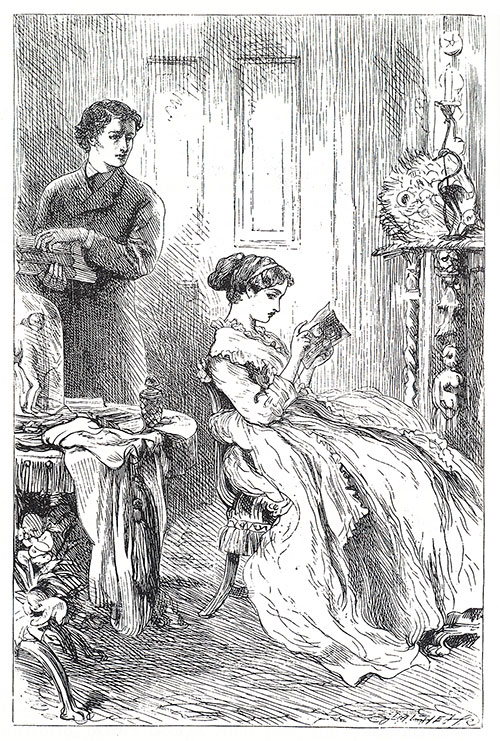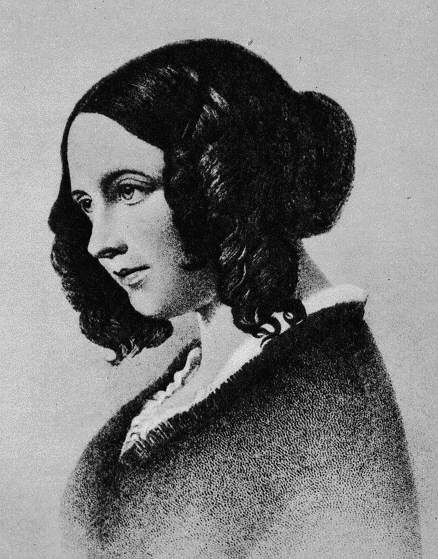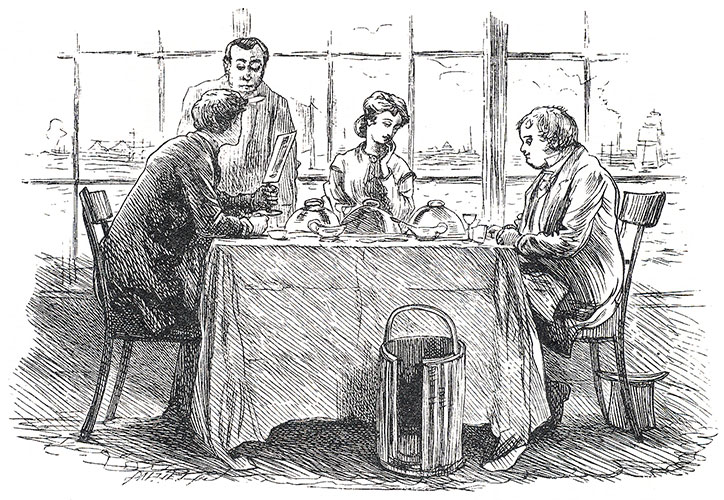“Confess this minute … that you did it to correct and amend me!”: Gaslighting in Dickens’s Novels

(https://www.charlesdickenspage.com/illustrations-web/Our-Mutual-Friend/Our-Mutual-Friend15.jpg)
This post is contributed by Dr. Katherine J. Kim, assistant professor at Molloy University in New York. Katherine’s other recent projects have been book chapters and articles on Edgar Allan Poe, Charles Dickens, and Catherine Crowe.
In the American Dialect Society’s Word of the Year contest, “gaslight” won in the “Most Useful/Likely to Succeed” category (Yagoda). The word was not a new one, as beyond its use to describe light from gas energy, the term took on a psychological meaning after the releases of the highly successful 1938 play Gas Light and its two film adaptations (the 1940 British film Gaslight and the 1944 American film), all of which take place in Victorian England. This version of the term “gaslighting” derived from how the gas lighting in the heroine’s home would dim each time her husband, who embarks on a campaign of manipulation to make her question her sanity, turns on the light in the attic to search for hidden jewels (Abramson 1-2).

As Ben Yagoda has noted, the popular use of the word increased around 2016 due to assertions that Donald Trump, who was then running for President of the United States, would say one thing and then later assert that he never said it. It also became increasingly used during the #MeToo movement and has spread across the world, as can be seen through the 2023 Indian Hindi-language mystery-thriller film Gaslight (Abramson 3). How to define and understand the term has become an increasingly discussed topic amongst scholars, leading to multiple academic articles and even a forthcoming collection on gaslighting in Victorian and Neo-Victorian culture edited by Nora Gilbert, Tara MacDonald, and Diana Bellonby (forthcoming). In “Turning up the Lights on Gaslighting,” Kate Abramson explains,
… [gaslighting] is a form of emotional manipulation in which the gaslighter tries (consciously or not) to induce in someone the sense that her reactions, perceptions, memories[,] and/or beliefs are not just mistaken, but utterly without grounds – paradigmatically, so unfounded as to qualify as crazy. Gaslighting is, even at this level, quite unlike merely dismissing someone, for dismissal simply fails to take another seriously as an interlocutor, whereas gaslighting is aimed at getting another not to take herself seriously as an interlocutor. It almost always involves multiple incidents that take place over long stretches of time; it frequently involves multiple parties playing the role of gaslighter, or cooperating with a gaslighter; it frequently involves isolating the target in various ways.
There appear to be some varying ways of defining and understanding the term “gaslighting” that are emerging. For instance, sociolinguistics professor Tracy Conner defines it as “[a] form of conscious or subconscious psychological manipulation mediated through language or by the actions of a speaker with a perceived higher status that has the effect of invalidating or denying the interlocutors’ reality or lived experience in an interaction or interactions, with the impact of discrediting them within a micro or macro context” (Madison). However, for some, the gaslighter need not be in a perceived position of power over the victim.
In short, gaslighters push victims (who are many times, but not always, women) to doubt their own perceptions and reasoning, which in turn can lead to victims questioning their sense of self. Furthermore, gaslighting need not involve just the victim and the primary victimizer, but can consist of a gaslighter attempting to make others question the victim (which can then lead to the victim’s self-questioning).

(https://commons.wikimedia.org/wiki/File:Catherine-dickens-young.png)
Gaslighting’s 1940s origin and more recent reemergence did not limit people from looking to before the twentieth century for instances of what might now be deemed gaslighting. Multiple historical figures became labelled gaslighters, including the writer of the original Gas Light play, Patrick Hamilton (Jones). One major name that became associated with gaslighting within the past several years is that of Charles Dickens. Although evidence of Dickens’s attempts to commit his wife Catherine to an insane asylum have been discussed as early as his own lifetime, many people chose not to focus on (or simply tried to dismiss) the information. It is widely accepted that the committal had more to do with his growing tired of Catherine and having begun an affair with the teenage actress Ellen Ternan than it did any actual fear for Catherine’s mental state. For instance, despite Catherine’s aunt writing of Dickens’s attempt to commit Catherine, scholar John Sutherland asserts that “[it] is extremely unlikely that Dickens intended to incarcerate Catherine. … What he may have intended was … to ‘show her the instruments’” (80). However, John Bowen’s Harvard archives research published in 2019 provides further evidence of Dickens pursuing his wife’s committal through letters from Catherine’s friend Edward Dutton Cook to William Moy Thomas, including one which states that Dickens “tried to shut her up in a lunatic asylum, poor thing! But bad as the law is in regard to proof of insanity he could not quite wrest it to his purpose” (13). Given the cultural context of the twenty-first century’s reinvigoration of the term “gaslighting” and global movements against abuses of power, such as #MeToo, the (re)discovery of Dickens’s callous action understandably drew widespread attention. For instance, The Daily Mail published an article with the lengthy title “Charles Dickens the Misogynist: He Championed Family Values – Yet the Novelist Was Cruel to His Wife, Hated His Mother, Had an Affair … and Obsessively Re-enacted the Murder of Prostitute Nancy in Oliver Twist, Writes A. N. Wilson.” Other news organizations and writers, such as Ana Samways (who subtitled a section of an article “Charles Dickens: The First Gaslighter”) for the New Zealand Herald and Kartikeya Shankar for the Times of India, have also published writings regarding Bowen’s research. The cultural climate allowed for the revivification of the term “gaslighting” that helped facilitate a previously less popular perspective on Dickens.
In addition to the concept of gaslighting fueling a new wave of popular interest in the biography of Dickens, it can provide new perspectives and raise new questions about some of the characters and situations in Dickens’s fictional works. Several of Dickens’s characters experience what can be deemed gaslighting as it is known today. For instance, Affery Flintwinch of Little Dorrit (1855-57) is an evident victim of gaslighting, as she is led by her abusive husband Jeremiah Flintwinch to mistrust her own senses and judgment, such as when she hears mysterious noises or when she sees Flintwinch’s twin brother, whom she did not know existed, and is told by her husband that she is simply dreaming (188 & 54). The physical and mental abuse she suffers only ends once Mr. Flintwinch abandons her and flees the country (759).

(https://victorianweb.org/art/illustration/eytinge/77.html)
Another example appears in Hard Times (1854) through the character Sissy Jupe, who is made to question herself as well as her understanding of the world. From the second chapter of the novel, Thomas Gradgrind, his teaching disciples, and their students make Sissy feel ignorant and unintelligent by negating her lived knowledge as the daughter of a man who is a clown and cares for the horses for a travelling circus in favor of generalized definitions, facts, and calculations. Thus, when she is asked for a dictionary definition of a horse, she is dumbfounded despite her hands-on experience with horses (9). Such actions include Gradgrind’s refusing to acknowledge “Sissy” as a name despite Sissy’s explanation that her father always calls her Sissy (8). Jessi Snider comments that “[not] only are Sissy’s values under assault …, but her very identity is considered, dismissed, and rewritten” (57). By the time she has lived with the Gradgrind family for some time because her father abandons her, Sissy’s self-confidence is shattered. She tells Gradgrind’s daughter Louisa, “‘[you] don’t know … what a stupid girl I am. All through school hours I make mistakes. … I can’t help them. They seem to come natural to me” (58).

(https://victorianweb.org/art/illustration/reinhart/ht17.html)
Through Sissy’s story and her being gaslit, Dickens attacks the educational system that centers on facts and figures. Gradgrind’s eldest children, Louisa and Tom, are severely psychologically damaged due to their schooling in the utilitarian and emotionless Gradgrind method (Sage 328). While Tom becomes a spoiled, selfish thief who must be banished to another country, Louisa is tempted by James Harthouse’s supposed nihilism: “[upon] a nature long accustomed to self-suppression, thus torn and divided, the Harthouse philosophy came as a relief and justification” (156). In a way, then, Louisa and Tom also have experienced gaslighting because their natural thoughts and passions were consistently deemed wrong by those around them. By the end of the novel, Sissy is a protective and redeeming force in the Gradgrind household, nursing Louisa back to health and shielding her from social ruin at the hands of Harthouse. Gradgrind’s conclusion that Sissy is too far gone to be corrected by his system of education reflects the resilience of her emotionally nurturing upbringing with circus folk and her understanding of herself and the way that she sees the world (89).
Sissy’s gaslighting and subsequent vindication differ greatly from another potential case in Our Mutual Friend (1864-65). In Dickens’s final completed novel, the poverty-stricken Bella Wilfer is given a momentary hope of fortune when told she was willed by the deceased Old Harmon to marry his son John, and that both will inherit his estate. That hope, already ambivalent because Bella feels her objectification and denial of personal agency, is quickly destroyed when Harmon is declared murdered after returning from his life overseas (27). The pain of her family’s poverty and the dashed potential of wealth leads Bella to declare herself a “mercenary little wretch” because she decides she must marry for money (319). After Harmon (who is not dead) reappears under the alias John Rokesmith, falls in love with Bella while she resides with the Boffins (the servants who inherited Old Harmon’s fortune because Harmon was declared murdered), Harmon, Nicodemus “Noddy” Boffin, and Noddy’s wife Henrietta plot to “cure” Bella of her mercenary goals. Boffin pretends to become a miser to show Bella the evils of prioritizing wealth, and Harmon refuses to reveal his true identity to her even after they marry and have a child, waiting until there is a crisis point that tests Bella’s fidelity (774).

(https://www.charlesdickenspage.com/illustrations-web/Our-Mutual-Friend/Our-Mutual-Friend33.jpg)
The plot, which seems to last about a year, supposedly makes Bella a better person and creates a happy ending for Bella and Harmon while breaking the evil remnants of Old Harmon’s heartless and miserly past actions. However, it can be understood as an example of gaslighting. Harmon and Mr. and Mrs. Boffin are cooperators in emotionally manipulating Bella and bringing her to question herself, her perspectives, and the way she sees the world. Additionally, though Bella calls herself mercenary and says she loves money, she has valid reasons behind her thinking and is not as wicked as she deems herself. For instance, when Boffin surprises her with a gift of money, her immediate thought is of her long-suffering father: “… the purse contained a bank-note for fifty pounds. ‘This shall be a joyful surprise for poor dear pa …’” (314). After treating her father to his lifelong dream of a new suit, Bella tells him that the remaining money is for him “to buy presents with for them at home, and to pay bills with, and to divide as you like, and spend exactly as you think proper” (321-22). Bella is not necessarily selfish in her desire for wealth, and even in contrast to the misers like Old Harmon depicted throughout the novel, she does not hoard money. Instead, she confesses, “[it’s] not that I care for money to keep as money, but I do care so much for what it will buy!” (319). Bella has experienced the pain poverty engenders. Furthermore, even seemingly innocent remarks have informed her understanding of money’s importance, such as when her father claims “‘money and goods are certainly the best of references,’” which Bella actually questions (39). Thus, her understanding of the possible importance of money in a capitalistic society is understandable.
In an article discussing the objectification and mistreatment of Bella by her supposed psychological saviors Harmon and the Boffins, Syd Thomas observes that “some critics have even heard a call coming from Bella to have herself ‘reformed’” (10). Such claims smack of the response of some abusers and attackers that their victims “wanted it.” Even though Bella is in need of reform, it is done by her own hands, not those of the men who manipulate her, as can be seen through her generosity to her family, her self-reflections throughout the novel, and her care and compassion for the little orphan Johnny, the poor Betty Higden, and another female character ill-used by the men around her, Lizzie Hexam. (For instance, Bella shows understanding and an admonishing of herself several times, such as when she speaks to Lizzie about love after Johnny’s death (527)). Thomas asserts that Harmon and Boffin’s “wish to dominate through their vision of ‘virtue’” leads to the effacement of Bella’s identity by the end of the novel as the dutiful Mrs. Rokesmith/Harmon: “the manipulations, the moral corrections, practiced by Harmon and Boffin are essentially self-serving and ‘murderous’” (8). Indeed, even the seemingly innocent remark that she now puts milk in her tea because it is what her husband prefers hints at her reduction of personal identity (Dickens 678). By creating a willful and flawed but genuinely good-hearted and improving woman who is “taught a lesson” by people she loves and supposedly love her, Dickens presents a story of gaslighting masquerading as reform.
Dickens’s novels provide examples of multiple forms in which gaslighting can occur and raise questions about what might constitute gaslighting. The gaslighting of Affery Flintwinch is at times comedic (although wrong of her husband to inflict upon her) and Sissy Jupe’s experience appears to vindicate her and punish her gaslighters (though she does become somewhat subject to Victorian middle-class female normalization), the plot against Bella is intriguing because it supposedly is for a good reason in the eyes of Harmon, the Boffins, and their creator, Dickens. However, a positive cause does not negate the gaslighting that occurs, especially since Bella had reason to think the way she did about the benefits of money and in fact did not necessarily need such action in order for her to learn and improve as a person. Thus while the real-life possibility that Dickens gaslit his wife is a tantalizing notion to examine, the fact that Dickens positions gaslighting in both negative and positive lights in his fictional writings is also evocative and will certainly be a source of further intriguing analysis.

Works Cited
Abramson, Kate. “Turning up the Lights on Gaslighting.” Philosophical Perspectives, vol. 28, 2014, pp. 1-30.
Bowen, John. “Madness and the Dickens Marriage: A New Source.” The Dickensian, vol. 115, part 1, no. 507, 2019, pp. 5-20.
Dickens, Charles. Hard Times. Oxford, Oxford UP, 2006.
—. Little Dorrit. London, Penguin Group, 1998.
—. Our Mutual Friend. Oxford, Oxford UP, 2008.
Jones, Patrick. “The Man Who Invented Gaslighting.” The Critic, 19 June 2020, https://thecritic.co.uk/the-man-who-invented-gaslighting/.
Madison, Caleb. “Are You Using Gaslight Correctly?” The Atlantic, 11 April 2022, https://www.theatlantic.com/newsletters/archive/2022/04/are-you-using-gaslight-correctly/629522/.
Sage, Victor. “Girl Number Twenty Revisited: Hard Times’s Sissy Jupe.” Dickens Quarterly, vol. 29, no. 4, Dec. 2012, pp. 325-335.
Samways, Ana. “Sideswipe: March 1: Crossing as Camouflage.” New Zealand Herald. 28 February 2019. https://www.nzherald.co.nz/entertainment/sideswipe-march-1-crossing-as-camouflage/LSUIPNEC7IXENA4TR6SOW5NWCI/.
Shankar, Kartikeya. “Lost in Time: The Forgotten Wife of Charles Dickens.” Times of India. 8 March 2022. https://timesofindia.indiatimes.com/life-style/books/features/lost-in-time-the-forgotten-wife-of-charles-dickens/articleshow/90076146.cms.
Snider, Jessi. “‘Call Yourself Cecilia’: Interpellation, Resistance, and the (Re)naming of Sissy Jupe in Hard Times.” Journal of Language, Literature, and Culture, vol. 63, no. 1, April 2016, pp. 50-60.
Sutherland, John. Victorian Fiction: Writers, Publishers, Readers. Palgrave Macmillan, 2005.
Thomas, Syd. “‘Pretty Woman, Elegantly Framed’: The Fate of Bella Wilfer in Dickens’s Our Mutual Friend.” Dickens Quarterly, vol. 14, no. 1, March 1997, pp. 3-23.
Wilson, A. N. “Charles Dickens the Misogynist: He Championed Family Values – Yet the Novelist Was Cruel to His Wife, Hated His Mother, Had an Affair … and Obsessively Re-enacted the Murder of Prostitute Nancy in Oliver Twist, Writes A. N. Wilson.” The Daily Mail, 23 May 2020, https://www.dailymail.co.uk/news/article-8351467/Charles-Dickens-cruel-wife-hated-mother-affair-writes-N-WILSON.html.
Yagoda, Ben. “How Old Is ‘Gaslighting’?” The Chronicle of Higher Education, 12 January 2017, https://www.chronicle.com/blogs/linguafranca/
